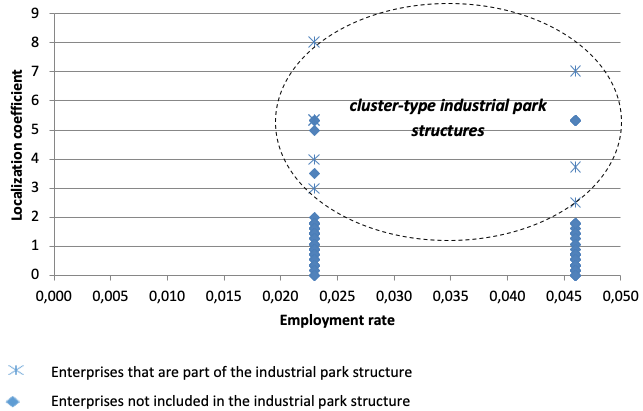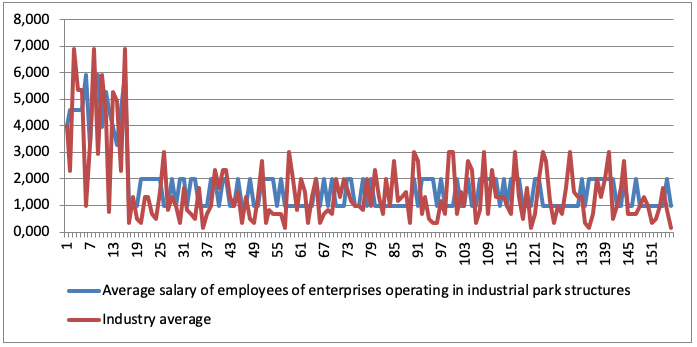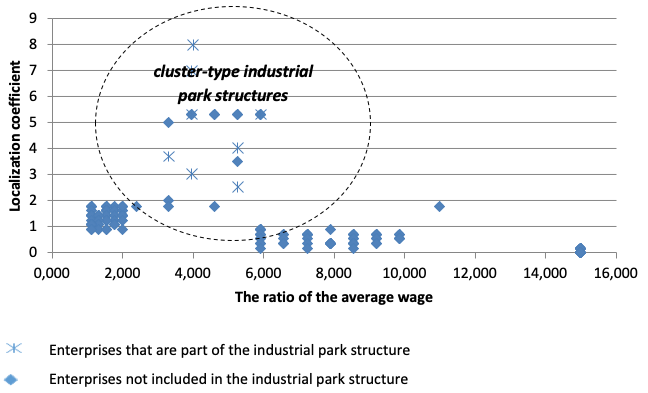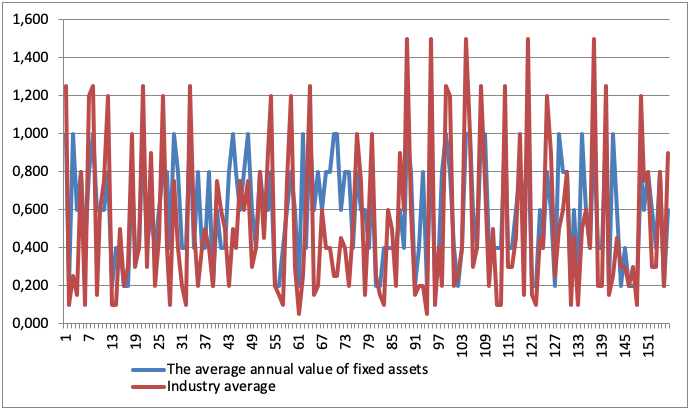

Vol. 40 (Number 13) Year 2019. Page 26
PLAKHIN, A.E. 1; OGORODNIKOVA, E.S. 2
Received: 17/01/2019 • Approved: 05/04/2019 • Published 22/04/2019
ABSTRACT: The purpose of this article is to test the methodology of evaluating additional effects for stakeholders of an industrial park structure. The research method involves the comparison of subjects indicators operating within the park structures with the average industry values of the indicators. The analysis is carried out in accordance with the following vectors: profitability of activities, fixed assets, number of employees, average monthly wage. The study shows that the following additional effects are characteristic of the participants in the industrial park structure: increased profitability of gross expenditures, higher dynamics of increase in tax revenues for all levels of the budget system, and high investment activity. |
RESUMEN: El objetivo de este artículo es probar la metodología para evaluar los efectos adicionales de los bisteckers de la estructura industrial del parque. La metodología del estudio consiste en comparar los indicadores de las entidades que operan en el marco de las estructuras de parques con los valores de los indicadores de la industria media. El análisis se realiza de acuerdo con los siguientes vectores: rendimiento de la actividad, fondos básicos, número de empleados, salario mensual promedio. El estudio muestra que los participantes en la estructura de parques industriales tienen los siguientes efectos adicionales: mayor rentabilidad de los costos brutos, una mayor dinámica de crecimiento de los ingresos fiscales en todos los niveles del sistema presupuestario, una mayor actividad de inversión. |
An analysis of the current database of scientific works allows us to conclude that the methodology of determining additional effects for stakeholders of the park structure is rather fragmented. There is a fairly large amount of research in which are presented some examples of the determining the “additional” effects for enterprises, for government bodies representing the interests of the park structure location and, indirectly, through the evaluation of average wages, issues of “additional” effects for employees are addressed. So there are no works, guided by which it would be possible to evaluate the additional benefits of the functioning of the industrial park structure for the population of the territory, there are also no works that allow to make a comprehensive look at the formation and distribution of additional effects in the context for the industrial park stakeholders.
The second round of methodological problems of measuring “additional effects” is connected with the determination of the sources of their occurrence. It is necessary, in our opinion, to allocate external and internal sources of the occurrence of "additional effects".
The sources of “external” savings are the presence of a common site infrastructure of an industrial park, which allows one to get quick access to resources, transportation channels, financial resources, consulting assistance, etc. For the first time, the occurrence of such effects was described (Marshall, A. 1920) and was called a manifestation of "external economy", by analogy with internal economy of scale production. External this savings is because it is born outside of each individual firm, in the process of mutual addition. As well as internal economy, external economy allows firms that receive it to be, ceteris paribus, more competitive.
The advantages of “external economy” are characteristic of all types of industrial park structures, while at the same time, industrial park structures of cluster type are also characterized by “internal economy”, the sources of which are different from the sources of “external economy” (Ruan, J. 2008). For cluster-type industrial park structures representing value chains, the sources of “additional effects” are the advantages of concentration and specialization. The concentration of firms in the general sphere of activity often leads to a deeper division of labor and the development of specialization. The coexistence of direct competitors, suppliers and customers leads to a better understanding of the specific requirements of customers, the characteristics of competitors' products and the capabilities of their suppliers, and a deep understanding of their distinctive competitive advantages. All this allows the company to differentiate its product (including through market segmentation and positioning). Differentiation increases the attractiveness of the product in the eyes of the customer, allows to form an individual market niche and strengthen competitive advantages (Lindqvist, G. 2009).
Also, the coverage by enterprises of the whole (or most part) of the value chain makes it possible and beneficial for residents of an industrial park structure to specialize in different stages of this process (Desrochers, P. 2001). The cluster approach has been widely known since the 90s of the last century, and by now a large complex of theoretical and applied works has appeared in this field, in particular, among the first were works (M.Porter 1990), (P. Krugman 1995 ), (MJWaits 1996). It should be noted that the cluster and the industrial park structure are not identical concepts. A cluster characterizes the form of organization of production, based on the effective specialization of participants connected by long-term network relationships. An industrial park structure, in turn, may not even possess cluster characteristics of the organization of production on its territory. Accordingly, focusing in the course of the present study on the object of study - the industrial park structure, the authors examine management issues in relation to all types of park structures, both with cluster characteristics and without them. Additional effects characteristic of a cluster can be in a park structure and not manifest themselves; for an industrial park structure, there are “external effects”, such as savings on infrastructure and tax preferences.
Let us consider the approaches to the determination of the composition of indicators, allowing to evaluate the presence of additional effects in the industrial park structure, table 1.
Table 1
Types of additional effects in the context of the industrial park
structure stakeholders and approaches to their determination
The list of the industrial park structure stakeholders |
External effects |
Internal effects |
Effect Determination Index |
Resident companies of the industrial park structure |
Saving on park infrastructure Tax preferences |
Scale economy Specialization and concentration of production |
Gross profitability of costs (%) |
Built-to-suit projects Tax preferences |
|
Cost of fixed assets |
|
General information and consulting infrastructure |
share innovation network |
Number and share of participants in the industrial park structure of the total number of registering patents |
|
R & D volume of residents |
|||
Management company |
|
Placement in the park of enterprises of the same network |
Gross profitability of costs (%) |
Government authorities of the region represented by development institutions |
|
Placement in the park of enterprises of the same network |
Number of employed |
Saving on park infrastructure Tax preferences |
Scale economy Specialization and concentration of production |
Gross profitability of costs for residents and management company (%) |
|
Built-to-suit projects Tax preferences |
|
Cost of fixed assets of residents and the management company |
|
Staff employed by residents and the management company |
Workforce specialization |
|
Average salary |
Suppliers and consumers of industrial park structure products |
Saving on park infrastructure Tax preferences |
Scale economy Specialization and concentration of production |
Gross profitability of costs for suppliers and consumers (%) |
State bodies represented by recipients of tax revenues |
|
Scale economy Specialization and concentration of production |
Tax revenue |
Population of the territory of the industrial park structure in the face of public organizations |
Uniform standards for the maintenance of the territory |
Placement in the park of enterprises of the same network |
Number of employed The volume of funds aimed at landscaping |
Thus, justifying the evaluating of additional effects within the industrial park structure, it is necessary to note the task of using similar criteria for evaluating the effectiveness of the activities of the stakeholders, as can be seen in Table 1, the assessment of the effects for most of the stakeholders is based on the rate of return. Figure 1 shows the algorithm of the developed method for identifying additional effects.
Figure 1
Algorithm for identifying additional effects

The choice of priorities for the development of industrial park structures is a generalizing vector of a regional strategy, which is dictated by factors and conditions of economic development. In other words, it is the choice of promising industries and industrial sectors. Such analytical procedures are carried out at the preparatory stage of creating the conceptual directions of regional industrial policy, therefore a professional analytical approach will be a guarantee for the successful implementation of this policy. The implementation of such a study requires the creation of a system of specific indicators, criteria and assessment of the determination of priorities.
Next, we will conduct a study to identify additional effects according to the industrial park structures of the Russian Federation. Figure 2 shows a comparison of the gross profitability ratio of the costs of enterprises operating within the industrial park structures of the Russian Federation and the industry average values of this indicator.
Figure 2
Illustration of the formation of additional effects in the form of excess profitability of
enterprises located in industrial park structures over the industry average values of this
indicator, 2017,%

As a result of the analysis of the comparison of the gross profitability ratio of the costs of enterprises operating within the industrial park structures of the Russian Federation and the industry average value of this indicator, 95 cases out of 156 observations of the excess of enterprises operating within industrial park structures were revealed.
Next, we will evaluate the peculiarities of the gross profitability ratio of the costs of enterprises operating in cluster-type park structures, that is, receiving, in addition to external ones, internal additional effects. For the selected set, a localization coefficient was calculated to determine cluster-type industrial park structures from the total set. The following figure shows the distribution of localization coefficients and the coefficient of dynamics of gross cost-effectiveness for industrial park structures.
Figure 3
The dependence of the gross profitability ratio of costs from
the coefficient of localization for industrial park structures

The theoretical relationship that is observed in the figure between the two coefficients is a straight line. In the long run, in an economy in equilibrium, the freedom to choose a region to locate production leads to a concentration of production where there is the greatest profitability. In turn, the location of production facilities within the cluster-type park structures creates an even greater profitability of costs compared to the total pool of park structures.
The following analysis vector consists in determining the amount of tax revenues for all levels of the budget system generated by residents of industrial park structures. The ratio of tax revenues for all levels of the budget system shows the dynamics of the increase in tax revenues. Using this coefficient, one can characterize the value added produced by residents of industrial park structures.
Figure 4
Illustration of the formation of additional effects in the form of exceeding the amount of
tax revenues for all levels of the budget system of enterprises located in industrial park
structures over industry average values

As a result of analyzing the comparison of the amount of tax revenues for all levels of the budget system of enterprises operating within the industrial park structures of the Russian Federation and their industry average values, 141 cases of 156 observations of the excess of the indicator for enterprises operating within the industrial park structures were revealed.
Next, we estimate the features of cluster-type park structures.
Figure 5
The dependence of the ratio of tax revenues for all levels of the budget
system from the coefficient of localization for industrial park structures

The analysis shows that residents of cluster-type industrial park structures are characterized by the dynamics of increase in tax revenues for all levels of the budget system, significantly exceeding the industry average value.
Next, we consider the possibility of forming additional effects for the territory where industrial park structures are located in the form of an increase in the number of employees. The number of employees shows the ratio of the level of employment of residents of the industrial park structure to the total number of employees by locality. With the help of this coefficient it is possible to characterize the social significance of the industrial park structure.
Figure 6
Illustration of the formation of additional effects in the form of exceeding the average
number of employees at enterprises located in industrial park structures above the industry
average values

As a result of the analysis of the ratio of the average number of people employed at enterprises operating within the industrial park structures of the Russian Federation and their industry average values, 42 cases out of 156 observations of the excess of the indicator for enterprises operating within the industrial park structures were revealed.
Next, we estimate the features of cluster-type park structures.
Figure 7
The dependence of the employment rate on the
localization rate for industrial park structures

The analysis shows that for residents of cluster-type industrial park structures, the share of employed is different from enterprises that do not work within the framework of park structures.
Next, we will consider the formation of additional effects for workers employed in industrial park structures in the form of exceeding the average monthly wage over the industry average values. The average wage ratio shows the ratio of wages in an industrial park structure to the average for the region. Using this coefficient, one can characterize the value added produced by residents of industrial park structures.
Figure 8
Illustration of the formation of additional effects in the form of exceeding the average
wage of employees of enterprises located in industrial park structures over the industry
average values

As a result of the analysis of the ratio of the average wage of employees of enterprises operating within the framework of industrial park structures of the Russian Federation and their industry average values, only 40 cases were found out of 156 observations of the excess of the indicator for enterprises operating within industrial park structures.
Next, we estimate the features of cluster-type park structures.
Figure 9
The dependence of the average wage rate on the
localization rate for industrial park structures

The analysis shows that residents of cluster-type industrial park structures do not have an average salary higher than the average for the region as well as for the general list of industrial park structures.
Next, we will consider the formation of additional effects in the form of exceeding the average annual value of fixed assets of enterprises located in industrial park structures over industry average values. The coefficient of the average annual value of fixed assets shows the ratio of the value of fixed assets in the industrial park structure to the industry average. With the help of this coefficient it is possible to characterize the investment activity produced by residents of industrial park structures.
Figure 10
Illustration of the formation of additional effects in the form of exceeding the average
annual value of fixed assets of enterprises located in industrial park structures above the
industry average values

As a result of the analysis of the ratio of the average annual value of fixed assets of enterprises operating within the industrial park structures of the Russian Federation and their industry average values, 79 cases out of 156 observations of the excess of the indicator for enterprises operating within industrial park structures were revealed. The analysis shows that for residents of cluster-type industrial park structures, the average annual value of fixed assets is higher than the industry average.
Figure 11
The dependence of the coefficient of the average annual value of fixed
assets from the coefficient of localization for industrial park structures

The dependence of the average annual value of fixed assets on signs of a cluster industrial park structure is present.
The study shows that the following additional effects are characteristic of the participants in the industrial park structure: increased gross profitability of costs, higher dynamics of increase in tax revenues for all levels of the budget system and high investment activity. At the same time, the activities within the industrial park structure do not affect the indicators of the number of employed and average salary.
The conducted studies allowed to conclude that such a form of organization as industrial park structures, which, as the experience of leading Russian regions shows, is one of the most successful tools for economic development, allows creating conditions for locating modern competitive industries, attracting investment resources and modernizing existing industries. Foreign experience also makes it possible to speak of industrial park structures as an effective platform for the sustainable development of the regional economy. In order to form an evidence base, the authors have developed and tested a technique to evaluate the additional effects arising from enterprises operating within an industrial park structures.
Cheshire, P.C., Malecki, E.J. Growth, development, and innovation: a look back and forward // Papers in Regional Science. 2004. 83. P. 249-267.
Desrochers, P. Geographical Proximity and the Transmission of Tacit Knowledge // Review of Austrian Economics. 2001. Vol. 14, No 1. P. 25-46. www.gmu.edu/rae/archives/V0L14_1_2001/2_desrochers.pdf
Krugman P. Development, geography and economic theory. – Cambridge: MIT Press, 1995. – P.651–667.
Lindqvist, G. Disentangling Clusters: Agglomeration and Proximity Effects. Dissertation for the Degree of Doctor of Philosophy, Ph.D., Stockholm School of Economics 2009, P.226
Marshall, А. 1920. Principles of Economics. 8th ed. London: Macmillan.
Plakhin, A. Industrial parks as an effective instrument of regional investment policy/ A. Plakhin, E. Ogorodnikova, M. Sidorenko// Proceedings of the 2nd International Conference on Economics and Management, Education, Humanities and Social Sciences (EMEHSS 2018). – 2018.
Plakhin, A. Methodological aspects of ontogenesis of regional industrial clusters. Proceedings of the international conference on trends of technologies and innovation sin economic and social studies// AEBMR-Advancesin Economics Businessand Management Research. – 2017. – Т. 38. – С. 524-530. – 0,89 п.л.
Porter, M.E. The Competitive Advantage of Nations. – London: Macmillan, 1990. 896 p.
Ruan, J., Zhang, X. Finance and Cluster-Based Industrial Development in China // IFPRI Discussion Paper. 2008. 00768. URL: http://www.ifpri.cgiar.org/sites/default/files/publications/ifpridp00768.pdf.
Waits M. J. State of cluster-based economic development in Arizona. In R. Breault (Ed.), Global networking of regional optics clusters. Denver, CO: International Society for Optical Engineering. (1996), pp. 1-10.
1. PhD in Economics, Associate Professor, Department of Management, Deputy Head of Management and Information Technologies Institute, Ural State University of Economics; Scopus Author ID: 57193735943 (62, 8 Marta St., Ekaterinburg, 620144, Russian Federation; e-mail: apla@usue.ru)
2. PhD in Economics, Associate Professor, Department of Management, Ural State University of Economics, Scopus Author ID: 57193735098 (62, 8 Marta St., Ekaterinburg, 620144, Russian Federation; e-mail: cmb_8@mail.ru)